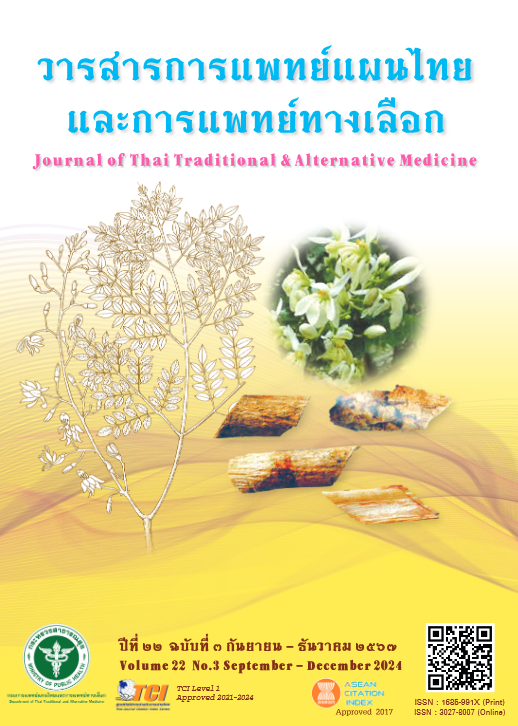Comparative Study of the Efficacy of Acupuncture at Houxi, Zhongzhu and Laozhen Acupoints versus Houxi and Xuanzhong Elecctro-acupoints: A Randomized Controlled Trial
Main Article Content
Abstract
Introduction and objectives: Current health problems in the working age population result from sitting and working in front of the computer or working in the same position for a long time. Such problems include cumulative stress tense muscles and most commonly neck and shoulder pain. Modern medicine uses treatment with pain killer drugs, muscle relaxants, or physical therapy. Traditional Chinese medicine uses herbal medications, Tuina massage, cupping, acupuncture on the neck, and acupuncture on the hands and feet. The latter method uses a small number of needles; it is convenient, safe, and reportedly effective for treating neck and shoulder pain. In this study, three acupoints at the hands were used (Houxi, Zhongzhu, and Laozhen) as they are anatomically clear for the experimental group, while another two acupoints (Houxi and Xuanzhong) at the hands and feet were used for the control group for treatment efficacy comparison.
Methods: Forty patients with neck and shoulder pain took part in this randomized controlled trial, 20 each in the experimental group and the control group; and each group received 3 treatment sessions. The patients’ pain was assessed with the short-form McGill Pain Questionnaire and a Neuropathic Pain Scale; and data analysis was undertaken with ANOVA statistics.
Results: According to data analyses for both groups, after treatment their pain levels dropped significantly. The difference in the mean pain scores before the first treatment and after the third treatment was 5.53 for the experimental group and 5.0 for the control group.
Discussion: After three treatments with acupuncture in both groups, the therapies were significantly effective in relieving pain; and there was no significant difference in pain reduction between both groups.
Conclusions and recommendations: Treatments of neck and shoulder pain with acupuncture at Houxi, Zhongzhu, and Laozhen acupoints and at Houxi and Xuanzhong acupoints had similar effectiveness. There was no significant difference between the two methods. Thus, both treatments are options for treating neck and shoulder pain, and are simple, convenient, effective, fast, and safe for use in clinical practice.
Article Details

This work is licensed under a Creative Commons Attribution-NonCommercial-NoDerivatives 4.0 International License.
References
Pisanu S. Neck shoulder pain, a popular problem for office workers (syndrome). [Internet]. 2020 [cited 10 Feb 2024]; Available from: https://www.phyathai.com/th/article/3054-ปวดคอ_บ่า_ไหล่_ปัญหายอดฮิต (in Thai)
Department of Disease Control. Department of Disease Control invites office workers to adjust 3 levels to reduce aches and pains and reduce the risk of office syndrome. [Internet]. 2018 [cited 10 Feb 2024]; Available from: https://pr.moph.go.th/?url=pr/detail/2/02/113832/. (in Thai)
Suthipas P. Neck pain, danger signal [Internet]. 2020 [cited 10 Feb 2024]; Available from: https://www.med.cmu.ac.th/web/news-event/news/hilight-news/3760/. (in Thai)
Thai Association for the Study of Pain. Recommendations for the treatment of myofascial pain syndrome & fibromyalgia 2020. Thai Association for the Study of Pain. 2020. P. 24-31.
Huachiew TCM Clinic. Cause of pain perspective on pain according to Chinese medicine [Internet]. 2023 [cited 10 Feb 2024]; Available from: https://www.huachiewtcm.com/content/7281/สาเหตุของอาการปวด-มุมมองความปวดตามศาสตร์แพทย์จีน. (in Thai)
Chen L, Wang HF, The law of cIinical optimum acupuncture selection on stiff neck of last ten years. Chinese Traditional Chinese Medicine Emergencies. 2018;27(11):1900-03
Tian L, Ma Tm. Acupuncture treatment of stiff neck. Journal of Practical Traditional Chinese Medicine and Internal Medicine. 2015;29(3):140-1
Yu X, Li HB, Wen SN, Progress in clinical research on acupuncture treatment for stiff neck. Journal of Liaoning University of Traditional Chinese Medicine. 2013;15(11):270-2
Wen JM, Xie PJ, Li T, Xie PL. Clinical research progress and discussion on the application of single point in the treatment of stiff neck. Journal of Liaoning University of TCM. 2016;18(7):213-6
Wu JH. 48 cases of stiff neck treated with Houxi Point Alone[J]. Hebei Traditional Chinese Medicine. 2006;28(8):623.
Zhang HL, Ju YL. Application of meridian differentiation of six points on neck and shoulder. Clinical Journal of Acupuncture and Moxibustion. 2010;26(8):54-5.


